TOYOTA TACOMA 2018 Owners Manual (in English)
Manufacturer: TOYOTA, Model Year: 2018, Model line: TACOMA, Model: TOYOTA TACOMA 2018Pages: 696, PDF Size: 11.72 MB
Page 631 of 696
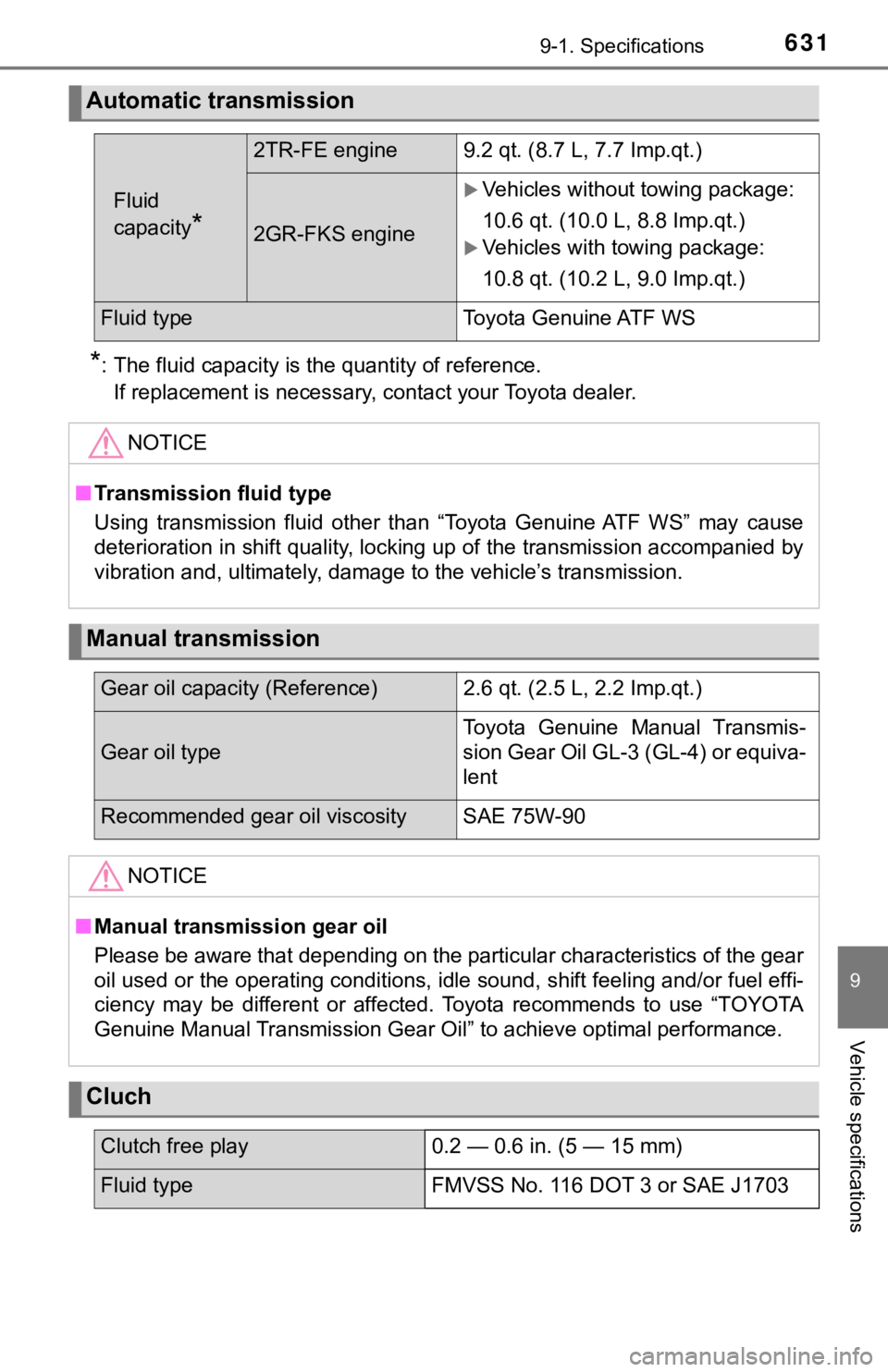
6319-1. Specifications
9
Vehicle specifications
*: The fluid capacity is the quantity of reference.If replacement is necessary, contact your Toyota dealer.
Automatic transmission
Fluid
capacity
*
2TR-FE engine 9.2 qt. (8.7 L, 7.7 Imp.qt.)
2GR-FKS engine
Vehicles without towing package:
10.6 qt. (10.0 L, 8.8 Imp.qt.)
Vehicles with towing package:
10.8 qt. (10.2 L, 9.0 Imp.qt.)
Fluid type Toyota Genuine ATF WS
NOTICE
■Transmission fluid type
Using transmission fluid other than “Toyota Genuine ATF WS” may cause
deterioration in shift quality, locking up of the transmission accompanied by
vibration and, ultimately, damage to the vehicle’s transmission .
Manual transmission
Gear oil capacity (Reference) 2.6 qt. (2.5 L, 2.2 Imp.qt.)
Gear oil typeToyota Genuine Manual Transmis-
sion Gear Oil GL-3 (GL-4) or equiva-
lent
Recommended gear oil viscosity SAE 75W-90
NOTICE
■
Manual transmission gear oil
Please be aware that depending on the particular characteristic s of the gear
oil used or the operating conditions, idle sound, shift feeling and/or fuel effi-
ciency may be different or affected. Toyota recommends to use “ TOYOTA
Genuine Manual Transmission Gear Oil” to achieve optimal perfor mance.
Cluch
Clutch free play0.2 — 0.6 in. (5 — 15 mm)
Fluid typeFMVSS No. 116 DOT 3 or SAE J1703
Page 632 of 696
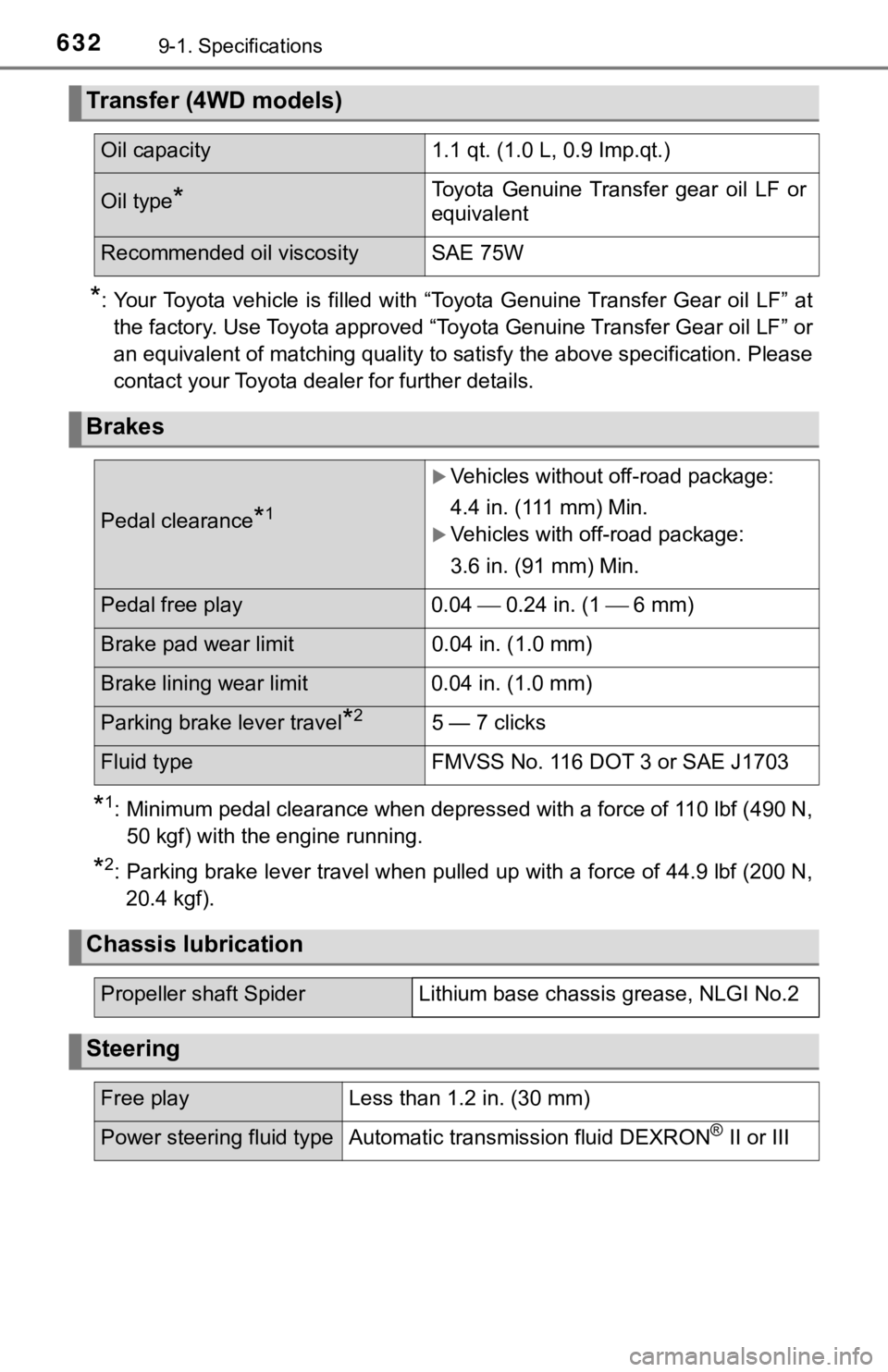
6329-1. Specifications
*: Your Toyota vehicle is filled with “Toyota Genuine Transfer Gear oil LF” at
the factory. Use Toyota approved “Toyota Genuine Transfer Gear oil LF” or
an equivalent of matching quality to satisfy the above specific ation. Please
contact your Toyota dealer for further details.
*1: Minimum pedal clearance when depressed with a force of 110 lbf (490 N,
50 kgf) with the engine running.
*2: Parking brake lever travel when pulled up with a force of 44.9 lbf (200 N,
20.4 kgf).
Transfer (4WD models)
Oil capacity 1.1 qt. (1.0 L, 0.9 Imp.qt.)
Oil type*Toyota Genuine Transfer gear oil LF or
equivalent
Recommended oil viscosity SAE 75W
Brakes
Pedal clearance*1
Vehicles without off-road package:
4.4 in. (111 mm) Min.
Vehicles with off-road package:
3.6 in. (91 mm) Min.
Pedal free play0.04 0.24 in. (1 6 mm)
Brake pad wear limit 0.04 in. (1.0 mm)
Brake lining wear limit0.04 in. (1.0 mm)
Parking brake lever travel*25 — 7 clicks
Fluid type FMVSS No. 116 DOT 3 or SAE J1703
Chassis lubrication
Propeller shaft SpiderLithium base chassis grease, NLGI No.2
Steering
Free playLess than 1.2 in. (30 mm)
Power steering fluid typeAutomatic transmission fluid DEXRON® II or III
Page 633 of 696
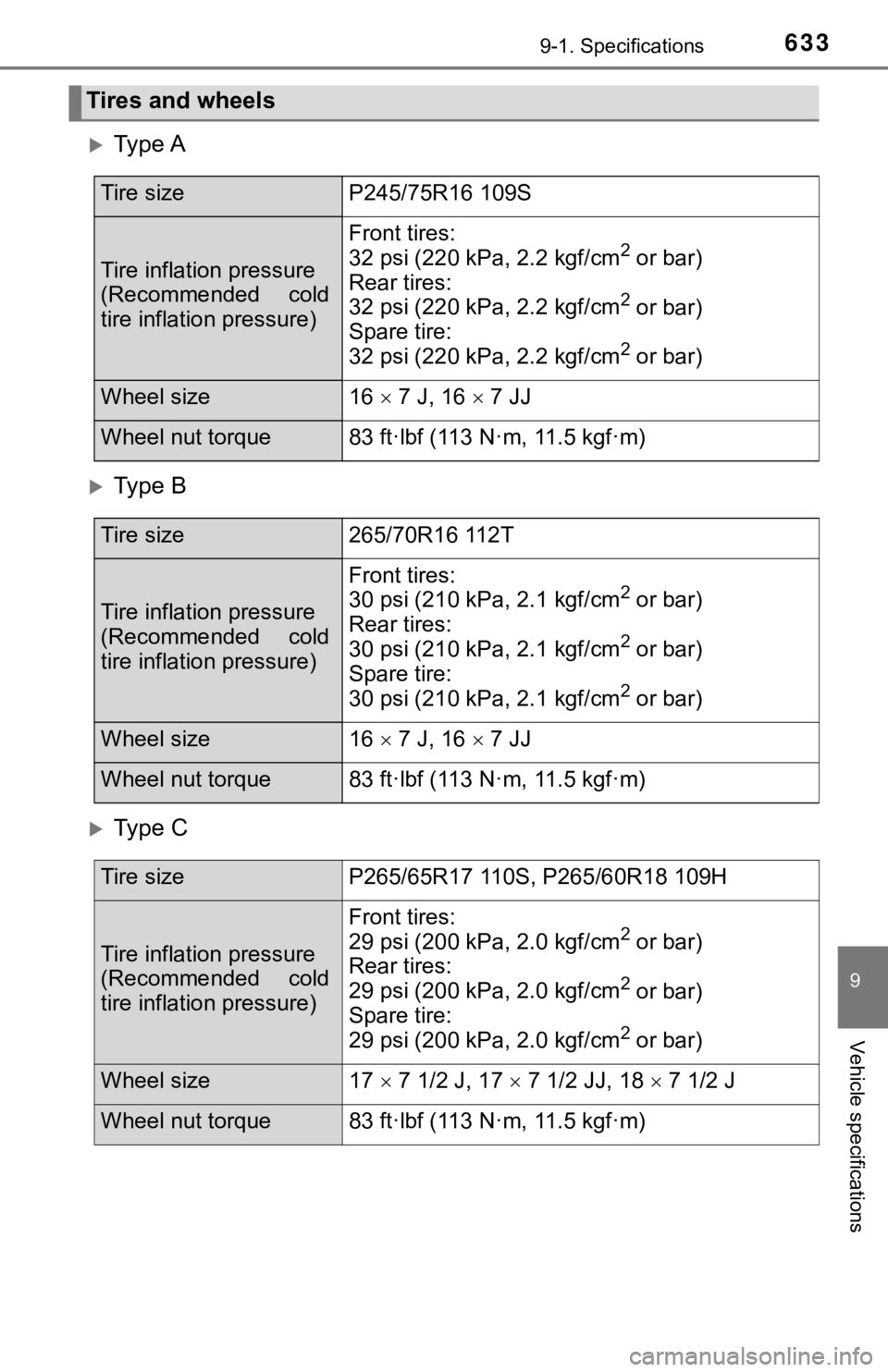
6339-1. Specifications
9
Vehicle specifications
Ty p e A
Ty p e B
Ty p e C
Tires and wheels
Tire sizeP245/75R16 109S
Tire inflation pressure
(Recommended cold
tire inflation pressure)
Front tires:
32 psi (220 kPa, 2.2 kgf/cm2 or bar)
Rear tires:
32 psi (220 kPa, 2.2 kgf/cm
2 or bar)
Spare tire:
32 psi (220 kPa, 2.2 kgf/cm
2 or bar)
Wheel size16 7 J, 16 7 JJ
Wheel nut torque83 ft·lbf (113 N·m, 11.5 kgf·m)
Tire size265/70R16 112T
Tire inflation pressure
(Recommended cold
tire inflation pressure)
Front tires:
30 psi (210 kPa, 2.1 kgf/cm2 or bar)
Rear tires:
30 psi (210 kPa, 2.1 kgf/cm
2 or bar)
Spare tire:
30 psi (210 kPa, 2.1 kgf/cm
2 or bar)
Wheel size16 7 J, 16 7 JJ
Wheel nut torque83 ft·lbf (113 N·m, 11.5 kgf·m)
Tire sizeP265/65R17 110S, P265/60R18 109H
Tire inflation pressure
(Recommended cold
tire inflation pressure)
Front tires:
29 psi (200 kPa, 2.0 kgf/cm2 or bar)
Rear tires:
29 psi (200 kPa, 2.0 kgf/cm
2 or bar)
Spare tire:
29 psi (200 kPa, 2.0 kgf/cm
2 or bar)
Wheel size17 7 1/2 J, 17 7 1/2 JJ, 18 7 1/2 J
Wheel nut torque83 ft·lbf (113 N·m, 11.5 kgf·m)
Page 634 of 696
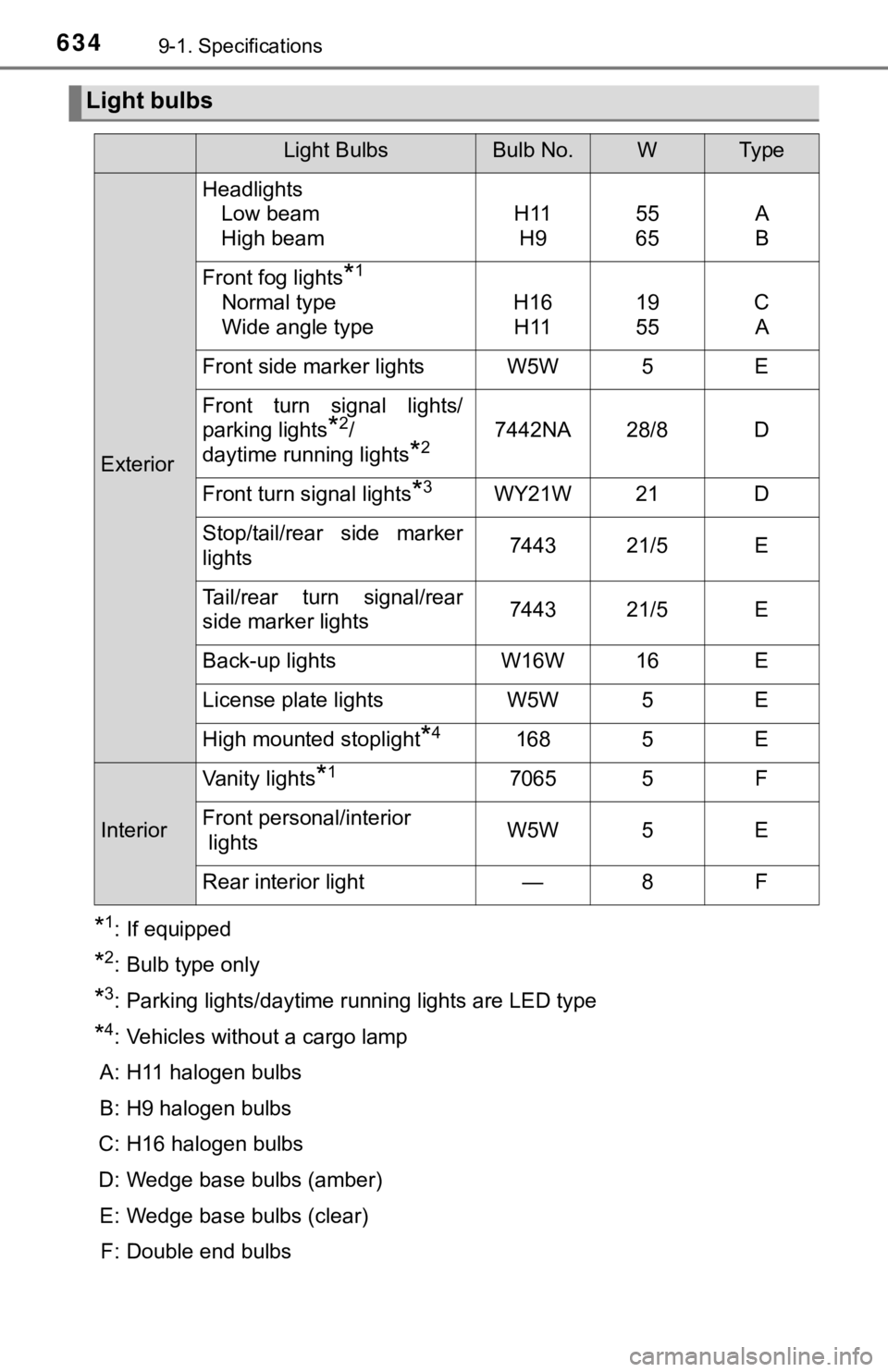
6349-1. Specifications
*1: If equipped
*2: Bulb type only
*3: Parking lights/daytime running lights are LED type
*4: Vehicles without a cargo lamp
A: H11 halogen bulbs
B: H9 halogen bulbs
C: H16 halogen bulbs
D: Wedge base bulbs (amber) E: Wedge base bulbs (clear)F: Double end bulbs
Light bulbs
Light BulbsBulb No.WTy p e
Exterior Headlights
Low beam
High beam H11
H9 55
65 A
B
Front fog lights
*1
Normal type
Wide angle type H16
H11 19
55C
A
Front side marker lights W5W 5 E
Front turn signal lights/
parking lights
*2/
daytime running lights
*27442NA 28/8 D
Front turn signal lights
*3WY21W 21 D
Stop/tail/rear side marker
lights 7443 21/5 E
Tail/rear turn signal/rear
side marker lights 7443 21/5 E
Back-up lights W16W 16 E
License plate lights W5W 5 E
High mounted stoplight
*4168 5 E
Interior Vanity lights
*17065 5 F
Front personal/interior
lights W5W 5 E
Rear interior light — 8 F
Page 635 of 696
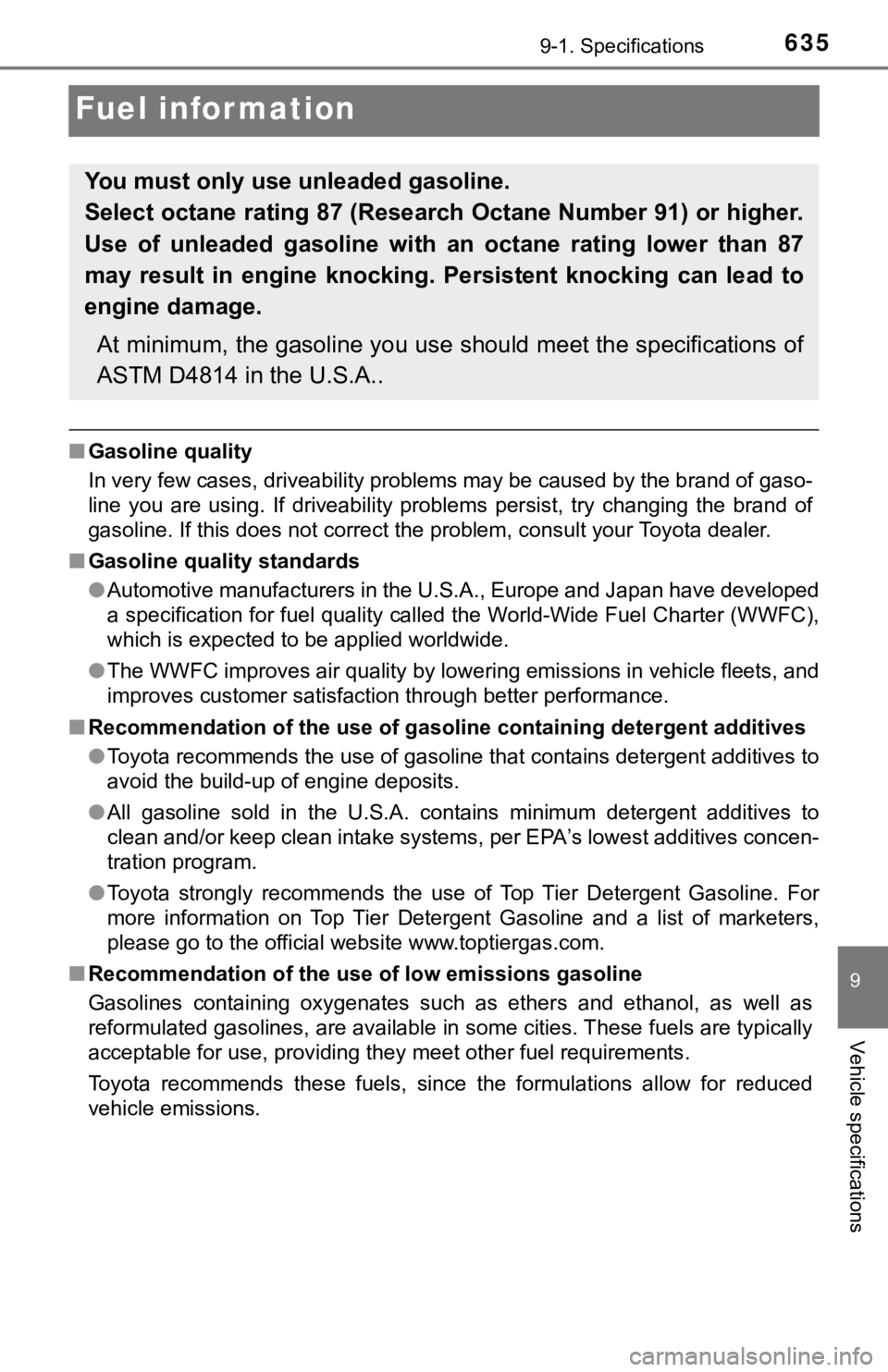
6359-1. Specifications
9
Vehicle specifications
Fuel information
■Gasoline quality
In very few cases, driveability problems may be caused by the b rand of gaso-
line you are using. If driveability problems persist, try changing the brand of
gasoline. If this does not correct the problem, consult your To yota dealer.
■ Gasoline quality standards
●Automotive manufacturers in the U.S.A., Europe and Japan have developed
a specification for fuel quality called the World-Wide Fuel Cha rter (WWFC),
which is expected to be applied worldwide.
● The WWFC improves air quality by lowering emissions in vehicle fleets, and
improves customer satisfaction through better performance.
■ Recommendation of the use of gaso line containing detergent additives
● Toyota recommends the use of gasoline that contains detergent a dditives to
avoid the build-up of engine deposits.
● All gasoline sold in the U.S.A. contains minimum detergent addi tives to
clean and/or keep clean intake systems, per EPA’s lowest additi ves concen-
tration program.
● Toyota strongly recommends the use of Top Tier Detergent Gasoli ne. For
more information on Top Tier Detergent Gasoline and a list of m arketers,
please go to the official website www.toptiergas.com.
■ Recommendation of the use of low emissions gasoline
Gasolines containing oxygenates such as ethers and ethanol, as well as
reformulated gasolines, are available in some cities. These fue ls are typically
acceptable for use, providing they meet other fuel requirements .
Toyota recommends these fuels, since the formulations allow for reduced
vehicle emissions.
You must only use unleaded gasoline.
Select octane rating 87 (Research Octane Number 91) or higher.
Use of unleaded gasoline with an octane rating lower than 87
may result in engine knocking. Persistent knocking can lead to
engine damage.
At minimum, the gasoline you use should meet the specifications of
ASTM D4814 in the U.S.A..
Page 636 of 696
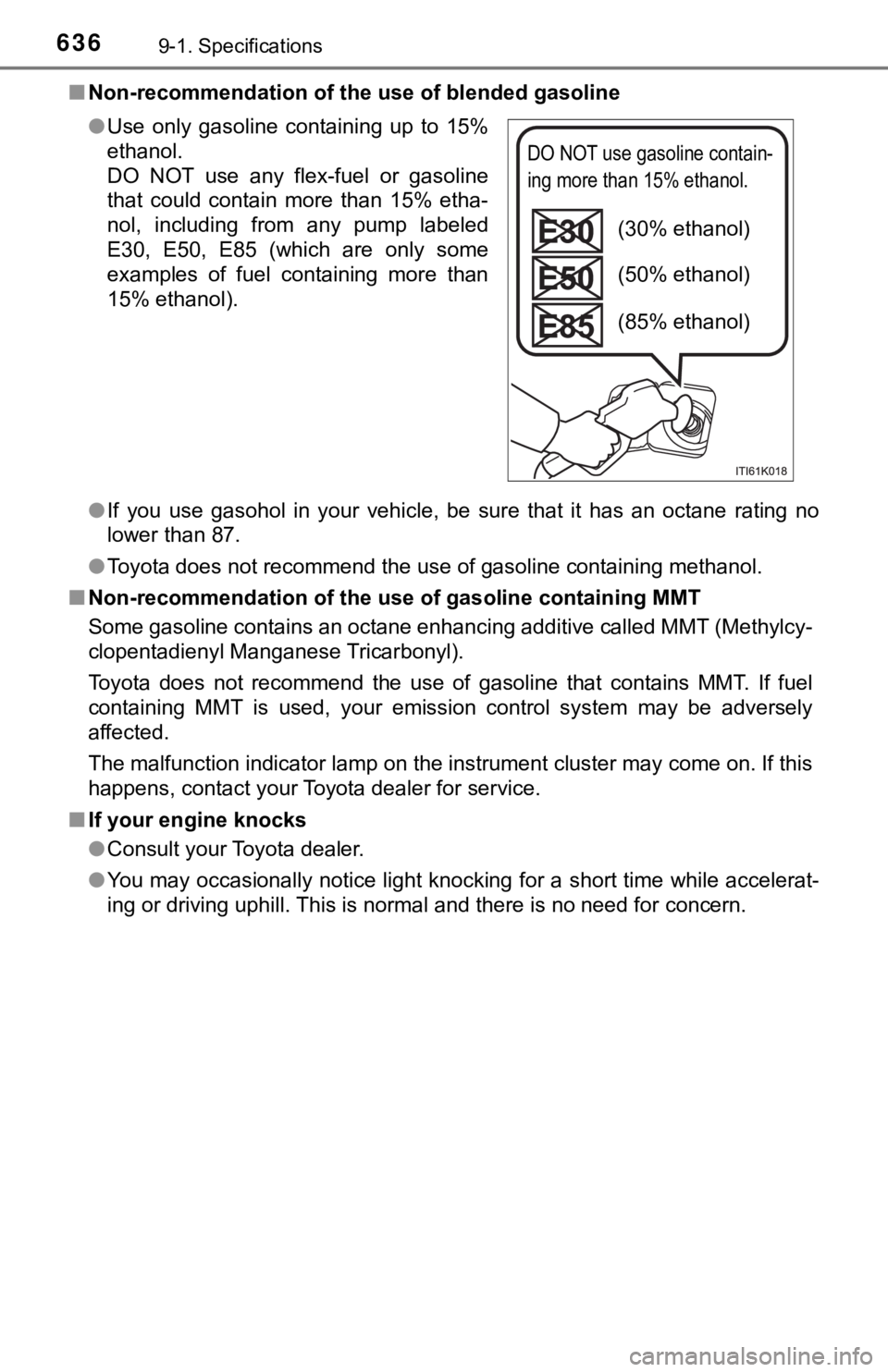
6369-1. Specifications
■Non-recommendation of the use of blended gasoline
●If you use gasohol in your vehicle, be sure that it has an octa ne rating no
lower than 87.
● Toyota does not recommend the use of gasoline containing methan ol.
■ Non-recommendation of the use of gasoline containing MMT
Some gasoline contains an octane enhancing additive called MMT (Methylcy-
clopentadienyl Manganese Tricarbonyl).
Toyota does not recommend the use of gasoline that contains MMT. If fuel
containing MMT is used, your emission control system may be adv ersely
affected.
The malfunction indicator lamp on the instrument cluster may come on. If this
happens, contact your Toyota dealer for service.
■ If your engine knocks
●Consult your Toyota dealer.
● You may occasionally notice light knocking for a short time whi le accelerat-
ing or driving uphill. This is normal and there is no need for concern.
●
Use only gasoline containing up to 15%
ethanol.
DO NOT use any flex-fuel or gasoline
that could contain more than 15% etha-
nol, including from any pump labeled
E30, E50, E85 (which are only some
examples of fuel containing more than
15% ethanol).
DO NOT use gasoline contain-
ing more than 15% ethanol.
(30% ethanol)
(50% ethanol)
(85% ethanol)
Page 637 of 696
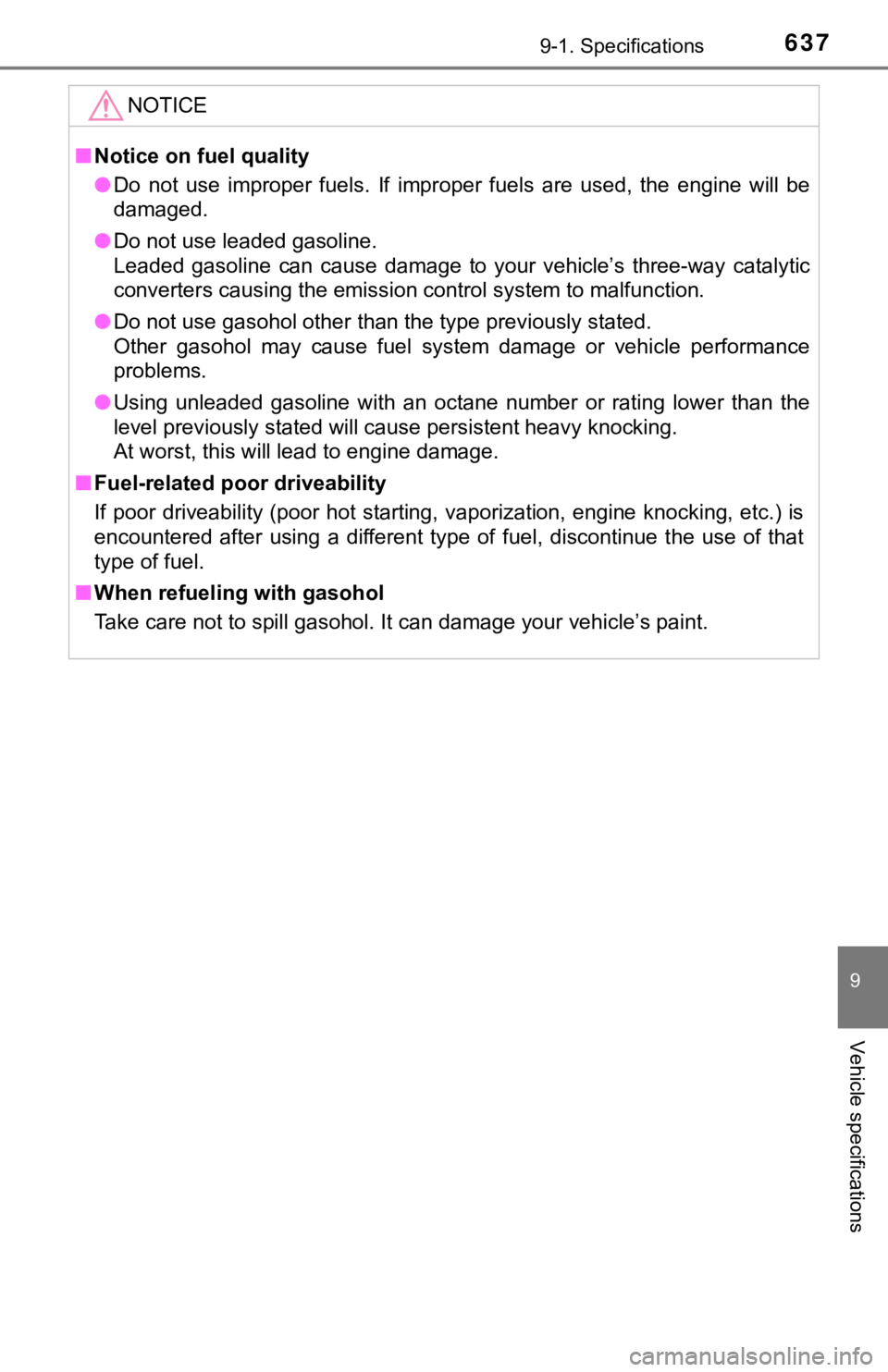
6379-1. Specifications
9
Vehicle specifications
NOTICE
■Notice on fuel quality
● Do not use improper fuels. If improper fuels are used, the engi ne will be
damaged.
● Do not use leaded gasoline.
Leaded gasoline can cause damage to your vehicle’s three-way ca talytic
converters causing the emission control system to malfunction.
● Do not use gasohol other than the type previously stated.
Other gasohol may cause fuel system damage or vehicle performan ce
problems.
● Using unleaded gasoline with an octane number or rating lower than the
level previously stated will cause persistent heavy knocking.
At worst, this will lead to engine damage.
■ Fuel-related poor driveability
If poor driveability (poor hot starting, vaporization, engine k nocking, etc.) is
encountered after using a different type of fuel, discontinue the use of that
type of fuel.
■ When refueling with gasohol
Take care not to spill gasohol. It can damage your vehicle’s paint.
Page 638 of 696
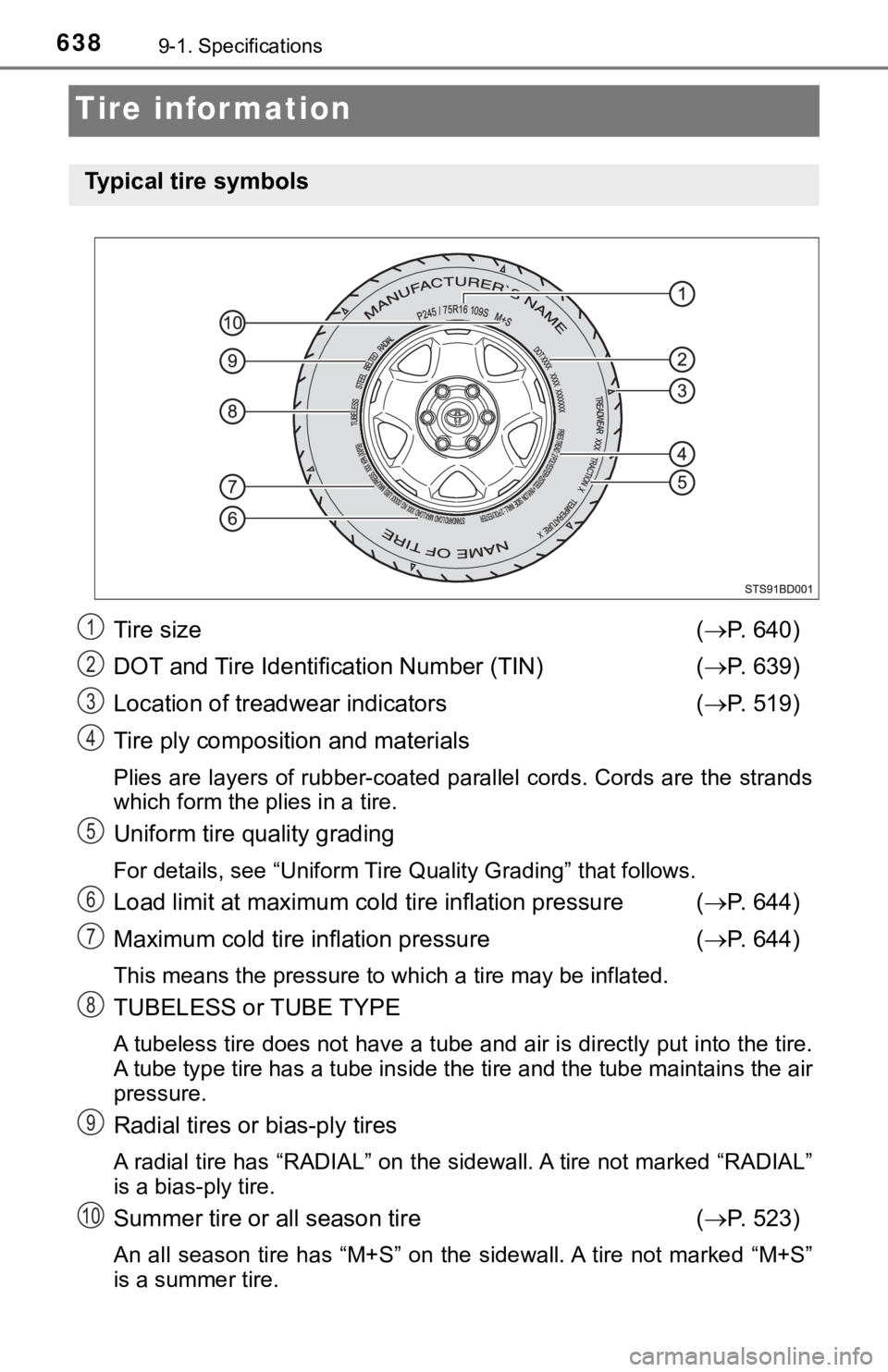
6389-1. Specifications
Tire information
Tire size ( P. 640)
DOT and Tire Identification Number (TIN) ( P. 639)
Location of treadwear indicators ( P. 519)
Tire ply composition and materials
Plies are layers of rubber-coated parallel cords. Cords are the strands
which form the p lies in a tire.
Uniform tire quality grading
For details, see “Uniform Tire Q uality Grading” that follows.
Load limit at maximum cold tire inflation pressure ( P. 644)
Maximum cold tire inflation pressure ( P. 644)
This means the press ure to which a tire may be inflated.
TUBELESS or TUBE TYPE
A tubeless tire does not have a tube and air is directly put into the tire.
A tube type tire has a tube insi de the tire and the tube mainta ins the air
pressure.
Radial tires or bias-ply tires
A radial tire has “RADIAL” on the sidewall. A tire not marked “ RADIAL”
is a bias-ply tire.
Summer tire or all season tire ( P. 523)
An all season tire has “M+S” on the sidewall. A tire not marked “M+S”
is a summer tire.
Typical tire symbols
1
2
3
4
5
6
7
8
9
10
Page 639 of 696
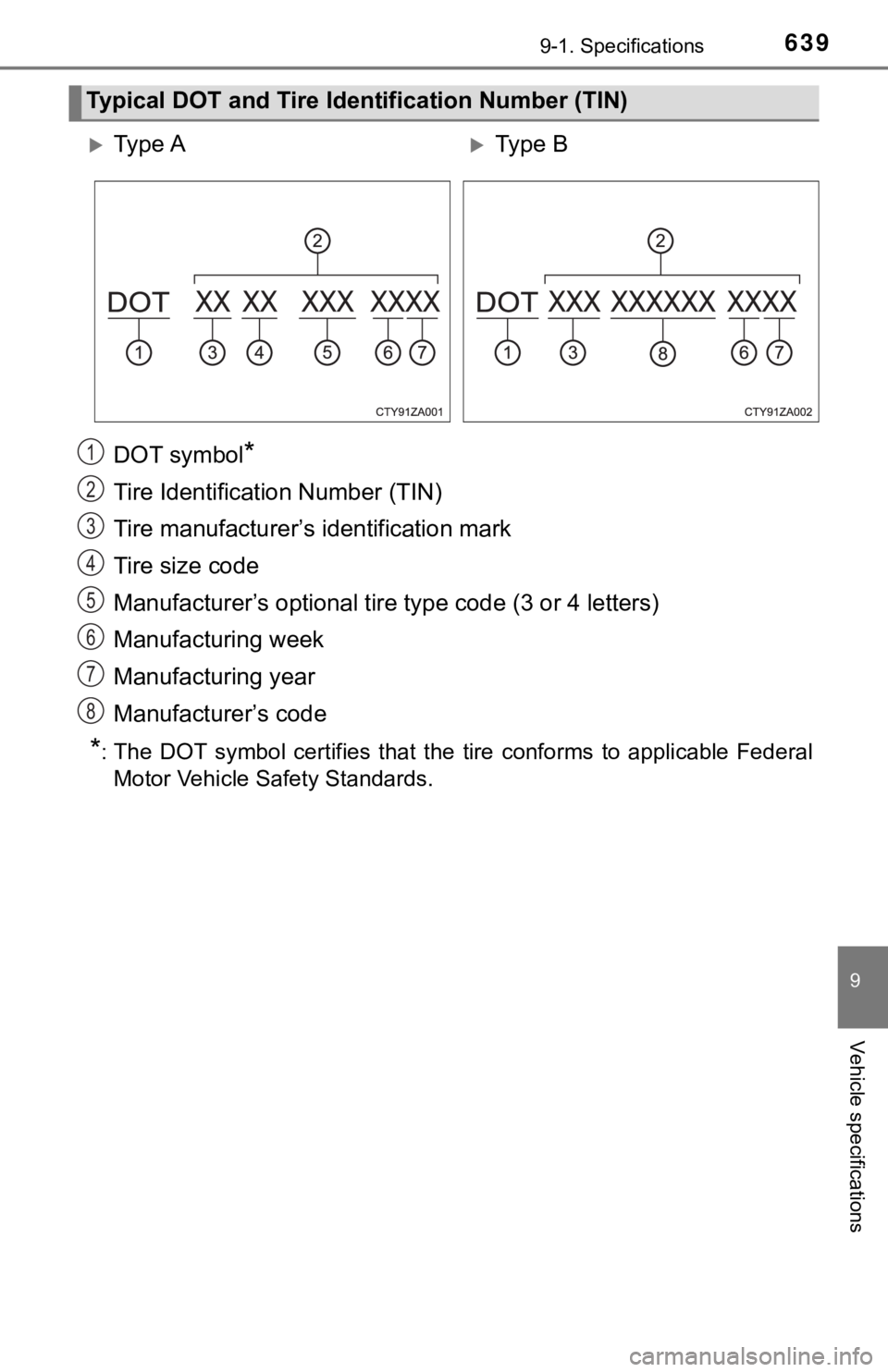
6399-1. Specifications
9
Vehicle specifications
DOT symbol*
Tire Identification Number (TIN)
Tire manufacturer’s identification mark
Tire size code
Manufacturer’s optional tire type code (3 or 4 letters)
Manufacturing week
Manufacturing year
Manufacturer’s code
*:The DOT symbol certifies that the tire conforms to applicable Federal
Motor Vehicle Safety Standards.
Typical DOT and Tire Iden tification Number (TIN)
Ty p e AType B
1
2
3
4
5
6
7
8
Page 640 of 696
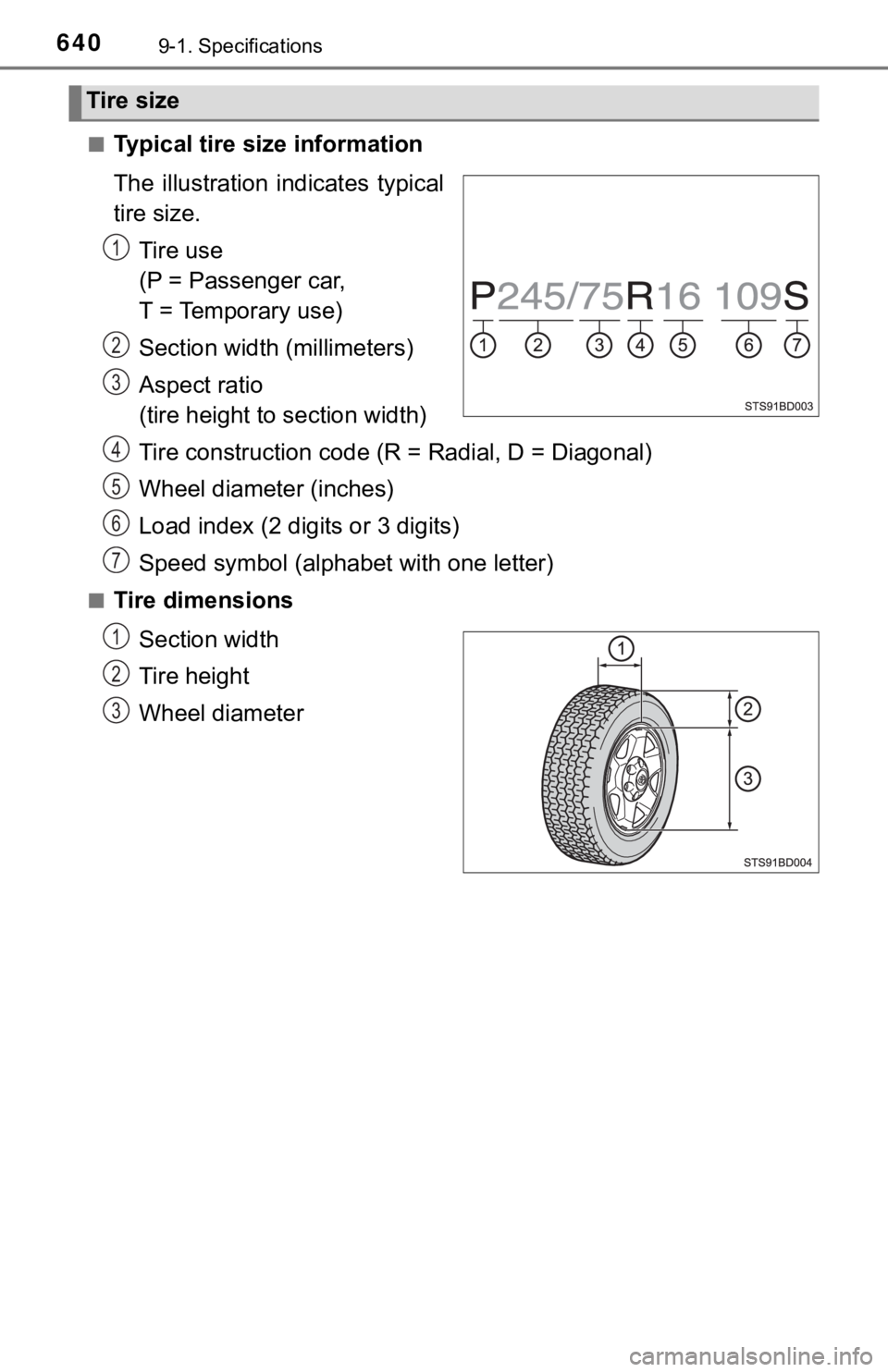
6409-1. Specifications
■Typical tire size information
The illustration indicates typical
tire size.
Tire use
(P = Passenger car,
T = Temporary use)
Section widt h (millimeters)
Aspect ratio
(tire height to section width)
Tire construction code ( R = Radial, D = Diagonal)
Wheel diameter (inches)
Load index (2 digits or 3 digits)
Speed symbol (alphabet with one letter)
■Tire dimensions
Section width
Tire height
Wheel diameter
Tire size
1
2
3
4
5
6
7
1
2
3